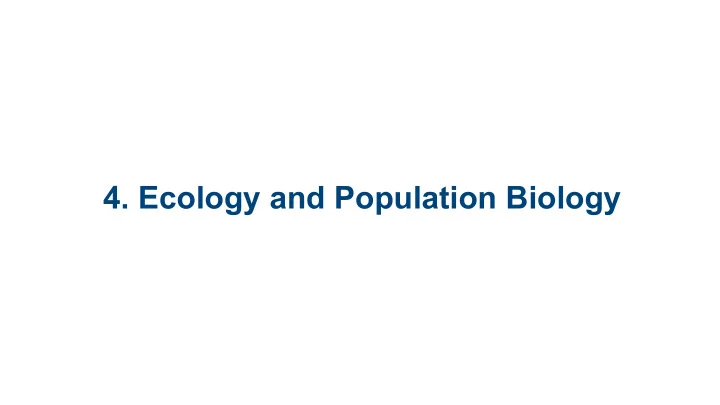

4. Ecology and Population Biology
4.1 Ecology and The Energy Cycle 4.2 Ecological Cycles 4.3 Population Growth and Models
4.4 Population Growth and Limiting Factors 4.5 Community Structure and Biogeography
4.1 Ecology and the Energy Cycle
What is ecology? eco – “home” ology – “study of” The study of how organisms interact and influence (or are influenced by) their environment.
Ecosystem – a group of populations within a given area, plus the environment they live in Population – total number of a given species of organism within an ecosystem Organism – an individual of a specific species
Community – the populations that interact with each other within an ecosystem Biosphere – the portion of the earth that includes all living things *also includes atmosphere (air), lithosphere (ground), and hydrosphere (water)
Habitat – the physical place where a species lives, which includes all biotic factors (living) and abiotic factors (non- living) Niche – the role a species plays within an ecosystem, it’s place in the food chain
Ecological Cycles- organisms interact with their environment in order to obtain the resources and energy necessary to live, creating cycles of energy and resources that allow the community to survive
All life requires energy to live, and energy can neither be made nor destroyed When we talk about the energy cycle, we’re talking about a transfer of energy from one form to another
Animals that feed only on other animals are called carnivores. Animals that consume other animals, as well photosynthetic organisms are omnivores. The levels in the food chain are called trophic levels.
Tertiary (apex) Consumer Secondary Consumer Primary Consumer Primary Producer
Primary Producers are also called autotrophs, as they produce their own food.
4.2 Ecological Cycles
Ecological Cycles- organisms interact with their environment in order to obtain the resources an energy necessary to live, creating cycles of energy and resources that allow the community to survive
4.3 Population Growth and Models
While there are a number of factors that support growth of a population, the growth of a population is held in check by limiting factors that exist within the environment. This balance of growth is at equilibrium under normal, unchanging, conditions.
Two major factors affect the rate of population growth: Birth rate, or natality Death rate, or mortality When the birth rate is equal to the death rate, the rate of population growth is constant.
There are two models for describing population growth: The exponential curve (J curve) The logistic curve (S curve)
The exponential curve model describes a population where there is no limit on the population growth. Realistically, this type of growth only exists during initial population growth.
The logistic curve model describes a population where the limits on the population growth are beginning to have an impact, and population growth is reaching an equilibrium state.
4.4 Population Growth and Limiting Factors
The limiting factors that keep population growth in check can be either biotic or abiotic. Biotic means biological factors, like over- population and food supply. Abiotic means physical factors, like fire and water conditions
As a general rule, the survival and establishment of an organism in an area is dependent upon 1) The availability of necessary elements for life in the minimum quantity 2) The controlled and constant supply of those elements
Because a number of factors contribute to maintaining homeostasis, population growth and density are usually controlled by multiple factors. Population density = # of organisms / area
Abiotic limiting factors (density-independent factors): the density of the population has no effect on the limiting factor. An example of this would be a forest fire. The density of populations in the area prior to the fire have no impact.
The limiting factors that are biotic are also called density-dependent factors; the density of the population can have a large impact on the limiting factor. An example of this is fecundity, or number of eggs, in round worms.
Species will compete for limited resources and they may move in or out of an area to find new niches, a process called dispersion. Species may disperse via emigration, immigration, and migration.
In some rare cases, one species will be wiped out by the other, a process called competitive exclusion.
Species sharing a range can have various relationships with each other. A predator is an organism that eats another for food, it’s prey.
Species that interact with each other have a relationship called symbiosis. Mutualism is a symbiotic relationship where both parties benefit from the interaction.
Amensalism is where one species is neither harmed nor helped, while the other is inhibited. Parasitism is where one species benefits, and the other is harmed.
The survival of a population is dependent upon maintaining a minimal viable population size. When the population drops below this size, there is the potential for extinction, or elimination of that species.
4.5 Community Structure and Biogeography
The limiting factors that keep population growth in check can be either biotic or abiotic.
Community structure – the characteristics of a specific community A community can be closed or open. An open community has indefinite boundaries, while a closed community has defined boundaries, called ecotones.
Communities grow and change over time, and sometime one community can take over another, a process called succession.
Biomes are large areas of land with similar climate, flora, and fauna. The earths biomes are divided into terrestrial and aquatic biomes.
Oceans may be thought of as consisting of different zones based on water depth and distance from the shoreline and light penetrance. Coral reefs, estuaries, and the freshwater biomes (include lakes, ponds, rivers, streams, and wetlands) are all unique aquatic biomes.
Recommend
More recommend